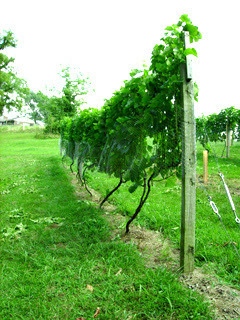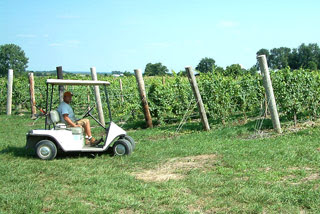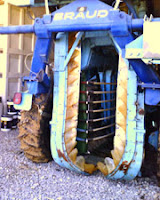 I know that I once said that budbreak is the "pinnacle of the viticulture experience," but now that veraison has hit the Chambourcin vines in the test vineyard I'll have to retract that statement. It seems as soon as the berries turn you can taste the spice, jam and dark fruit on the skins, and I can't help popping a few in my mouth as I walk down the aisles. This really is as good as it gets. There's a lull now that I'm finishing with the bird netting, the vines are trimmed and the sprays are up to date. The summer is drying out and the vines are less vigorous. Now I can enjoy veraison until the next crisis. There is so much potential in the fruit at this stage.
I know that I once said that budbreak is the "pinnacle of the viticulture experience," but now that veraison has hit the Chambourcin vines in the test vineyard I'll have to retract that statement. It seems as soon as the berries turn you can taste the spice, jam and dark fruit on the skins, and I can't help popping a few in my mouth as I walk down the aisles. This really is as good as it gets. There's a lull now that I'm finishing with the bird netting, the vines are trimmed and the sprays are up to date. The summer is drying out and the vines are less vigorous. Now I can enjoy veraison until the next crisis. There is so much potential in the fruit at this stage.Veraison is easily identifiable in red wine grapes...it's the stage where they start to take on rust and and then purple color. In white wine grapes, the hard green berries will begin to turn golden and the skins will become translucent, and it's like peering into a glass marble. Veraison engages the white clusters more subtly, but it's no less enjoyable.
Veraison also means that the grapes are sweetening and become more palatable to the critters, so it's a period of heightened concern. Rots also like the sugars, so you have to have enough stomach to sweat it out while you watch clusters whither away and hope it remains limited to only a tiny portion of the crop.










